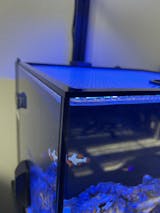Kreative Reefer
Tideline AIO 21.4G Cube Honeycomb Lid
Tideline AIO 21.4G Cube Honeycomb Lid
SKU:TL21LIDHC
Share
Experience the ultimate protection for your valuable fish with the Tideline AIO 21.4G Cube Honeycomb Lid. Having a lid ensures the safety and security of your fish, safeguarding them from potential accidents and preserving your investment. Don't risk losing your precious fish, put a lid on it!
- Made with 2 layers of 1/4” thick high-quality cast acrylic
- Our lid provides a full back support built-in which keeps fish and other livestock from jumping into your sump area and also allows for cabling into the tank area for pumps or other equipment.
- Includes a feeder hole with a cover
- No PAR loss was found when testing with an AI Prime 16 HD
Discover the full range of options for your lid needs, as different materials offer unique benefits. Don't settle for one choice, instead, explore the potential of acrylic as a superior alternative to polycarbonate. Let your research guide you towards the perfect choice for you and your aquarium.
Note: This item is made after ordering, please allow up to 5-6 days to process.
Couldn't load pickup availability



Acrylic Lids vs Polycarbonate Lids?
There are actually more than two materials when it comes to these plastics. You have extruded acrylic, cast acrylic, and polycarbonate (Lexan) commonly used for lids in the aquarium hobby, or glass as a plastic alternative.
Polycarbonate is often preferred over acrylic in the aquarium hobby due to its lower tendency to warp or discolor. Polycarbonate is stronger and is less prone to warping or discoloring, most vendors will cut the center out and use netting to also help prevent warping while allowing more light to pass through. Extruded Acrylic is a cheaper material and most prone to warping and discoloring. Cell Cast Acrylic is less prone to warping, but should not yellow due to the U.V. inhibitors added during the manufacturing process.
With that said, we do use high-quality cell cast acrylic for our products and we personally have not seen any major warping with our lids or discoloring. Some of our lids have been on aquariums for several years. Warping has been noticed in some cases, but only minimal. We typically try to cut enough material out so the humidity and temperature is equalized as much as possible on both sides of the material. More solid pieces of acrylic like ATO lids where the material cannot equalize on both sides will warp very noticeably, if the piece needs to be solid it is recommended to fasten it in some fashion (glue or hardware).
We offer acrylic as an alternative to polycarbonate, some people to do not care about slight warping as long as it looks good and does the job intended. And acrylic is also usually a more affordable alternative than polycarbonate so it helps some hobbyist save the money while still having a good product.
We hope this helps our customers and sets expectations for moving forward so you can make the best decision for your needs. Please reach out to us if you have any questions. We are always happy to help!







